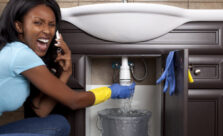Are you looking to take on a DIY plumbing project? With some basic tools and knowledge, you can make simple repairs around the house on your own.
In this article, you’ll learn how to identify the problem, gather the right tools, understand the basics of plumbing, and take safety precautions.
So, if you’re ready to get your hands dirty, let’s get started!
Identifying the Problem
Figuring out what’s wrong is the first step, so take a look and see what you can spot!
Inspect the area around the plumbing fixture or pipe to determine what is causing the issue. Is water overflowing from the sink or is the toilet tank not filling? Is a pipe leaking or is a faucet dripping?
Knowing the source of the problem can help you decide what type of fix you need to make.
Next, try to narrow down the cause of the problem. Is the fixture clogged or is it broken? Is the pipe loose or is it corroded?
Checking for signs of wear and tear or blockages can help you determine the best course of action to take. Taking the time to identify the issue can save you from a lot of frustration and costly repairs down the road.
Gathering the Right Tools
Gathering the right tools for the job is essential for a successful repair. Before you begin to repair your plumbing problem, it’s important to gather the necessary tools.
Depending on the job, you may need common tools like a wrench, pliers, and a screwdriver. You may also need specialized tools such as an adjustable pipe wrench, a pipe cutter, a blowtorch, or a propane torch.
If you’re not sure what you need, you can consult your local hardware store for advice. Once you have the right tools, you’ll be well prepared to tackle the job.
Understanding the Basics of Plumbing
Gaining an understanding of the basics of plumbing is key to successful repairs. Before you get started, it’s important to familiarize yourself with the components of a plumbing system and how they work together.
Your plumbing system is made up of five main components: pipes, fixtures, valves, drains, and vents. Pipes are the pathways that carry water and other liquids through your plumbing system. Fixtures are the devices, such as toilets and faucets, that control the flow of water. Valves are the mechanisms used to regulate water pressure and flow. Drains are the openings where wastewater leaves your home. Lastly, vents allow air to enter the plumbing system and provide an exit for sewer gases.
Knowing how these components work together and how to identify them is the first step in making DIY repairs.
When it comes to plumbing repair, it’s important to remember that prevention is key. Regularly inspect all components of your plumbing system and replace any damaged parts as soon as possible. Additionally, have a professional come in to check your plumbing system once a year. Doing so can help you avoid costly repairs in the future.
Safety Precautions for DIY Plumbing
Before you start making DIY plumbing repairs, it’s essential to take safety precautions – otherwise, you could be putting yourself in danger!
The first safety precaution is to make sure you always shut off the water before making any repairs. This will help ensure that you don’t get sprayed with water while you’re trying to fix the problem.
Additionally, you should always wear protective gloves, eyewear, and clothing while doing any work on your plumbing. This will help protect you from any sharp objects or dangerous chemicals that you may come in contact with.
Finally, it’s important to make sure you have the right tools for the job. Make sure you have the right wrenches, screwdrivers, and other tools before you start any work on your plumbing. Having the right tools will make the job much easier and help you get it done correctly.

Leave a Reply